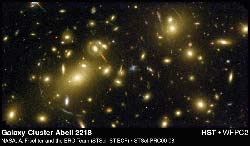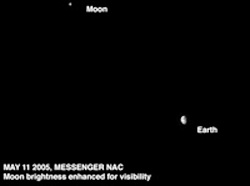This area deals with the fundamental laws and building blocks of nature and how they interact, the properties and the behavior of matter, and research into space and time and their structures.
innovations-report provides in-depth reports and articles on subjects such as astrophysics, laser technologies, nuclear, quantum, particle and solid-state physics, nanotechnologies, planetary research and findings (Mars, Venus) and developments related to the Hubble Telescope.

Fifty years after his death, Albert Einstein’s work still provides new tools for understanding our universe. An international team of astronomers has now used a phenomenon first predicted by Einstein in 1936, called gravitational lensing, to determine the shape of stars. This phenomenon, due to the effect of gravity on light rays, led to the development of gravitational optics techniques, among them gravitational microlensing. It is the first time that this well-known technique has b

Mercury-bound NASA probe snaps first approach shots before August flyby
NASA’s Mercury-bound MESSENGER spacecraft — less than three months from an Earth flyby that will slingshot it toward the inner solar system — successfully tested its main camera by snapping distant approach shots of Earth and the Moon.
MESSENGER took a set of six pictures on May 11 with the narrow-angle camera in its Mercury Dual Imaging System, or MDIS. Earth was about 18.4 million miles (29.6 mi

On 4 July 2005, the NASA Deep Impact spacecraft will visit Comet 9P/Tempel 1. It will launch a 370 kg impactor probe that should produce a crater on the surface of the comet and a plume of gas, dust and ejected material.
Although dramatic images of the impact may be sent to Earth in near-real time by the Deep Impact spacecraft and its impactor, the spacecraft themselves have limited remote sensing capability. The parent spacecraft will observe the impact from 500 kilometres di

New research from the National Center for Atmospheric Research (NCAR) links a particular magnetic structure on the Sun with the genesis of powerful solar storms that can buffet Earth’s atmosphere. The research may enable scientists to create more accurate computer models of the solar storms, known as coronal mass ejections (CMEs), and could eventually point the way to forecasting the storms days before they occur. Sarah Gibson, a scientist at NCAR’s High Altitude Observatory (HAO), wil

Type Ic supernovae, or hypernovae, may be source of powerful bursts
Observations by two of the world’s largest telescopes provide strong evidence that a peculiar type of exploding star may be the origin of elusive gamma-ray bursts that have puzzled scientists for more than 30 years.
A team of astronomers from Italy, Japan, Germany and the United States, including the University of California, Berkeley, conclude from observations with the Keck and Subaru telescopes in H

The same kind of chemical coating used to shed rainwater from aircraft and automobile windows also dramatically enhances the sensitivity and reaction time of hydrogen sensors. Hydrogen sensor technology is a critical component for safety and other practical concerns in the proposed hydrogen economy. For example, hydrogen sensors will detect leaks from hydrogen powered cars and fueling stations long before the gas becomes an explosive hazard.
The discovery was made by a team led by